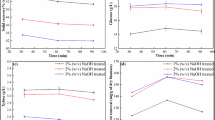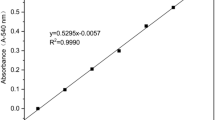Abstract
Overgrowth of aquatic plants, such as water chestnut, has been reported as a regional problem in various areas. We proposed cascade utilization of water chestnut through the recovery of phenolics, phosphorus, and sugars. Phenolics were extracted using 50 g (wet weight) of biomass with 300 mL of acetone, methanol, or hot water, and the yields of total phenolics were 80.2, 56.2, and 49.7 mg g−1 dry weight of native biomass, respectively. The rate of eluted phosphorus in the phenolic extraction step was 8.6, 14.8, and 45.3 % of that in the native biomass, respectively, indicating that the use of polar organic solvents suppressed phosphorus elution at the phenolic extraction step. Extraction of phosphorus following the phenolic extraction was combined with alkaline pretreatment (1 % NaOH solution) of biomass for saccharification; 64.1 and 51.0 % of phosphorus in the native biomass were extracted using acetone and methanol for the phenolic extraction, respectively. Saccharification following the alkaline pretreatment showed that the glucose recovery rates were significantly increased (p < 0.05) with the phenolic extraction step compared to alkaline pretreatment alone. This finding indicates that extraction of phenolics not only provides another useful material but also facilitates enzymatic saccharification.




Similar content being viewed by others
References
Akao S, Maeda K, Nakatani S, Hosoi Y, Nagare H, Maeda M, Fujiwata T (2012) Comparison of simultaneous and separate processes: Saccharification and thermophilic l-lactate fermentation of catch crop and aquatic plant biomass. Environ Technol 33:1523–1529. doi:10.1080/09593330.2012.669412
Andersen RA, Berges JA, Harrison PJ, Watanabe MM (2005) Appendix A. Recipes for freshwater and seawater media. In: Andersen RA (ed) Algal culturing techniques. Elsevier Academic Press, Waltham, MA, pp 429–538
APHA, AWWA, WEF (1998) Standard methods for the examination of water and wastewater, 20th edn. American Public Health Association/ American Water Work Association/Water Environment Federation, Washington, DC
Chiang PY, Ciou JY, Hsieh LC (2008) Antioxidant activity of phenolic compounds extracted from fresh and dried water caltrop pulp (Trapa taiwanensis Nakai). J Food Drug Anal 16:66–73
Ciou JY, Wang CCR, Chen J, Chiang PY (2008) Total phenolics content and antioxidant activity of extracts from dried water caltrop (Trapa taiwanensis Nakai) hulls. J Food Drug Anal 16:41–47
Dai J, Mumper RJ (2010) Plant phenolics: Extraction, analysis and their antioxidant and anticancer properties. Molecules 15:7313–7352. doi:10.3390/molecules15107313
Fujiwara T (2012) Concept of an innovative water management system with decentralized water reclamation and cascading material-cycle for agricultural areas. Water Sci Technol 66:1171–1177. doi:10.2166/wst.2012.246
Gould JM (1984) Alkaline peroxide delignification of agricultural residues to enhance enzymatic saccharification. Biotechnol Bioeng 26:46–52. doi:10.1002/bit.260260110
Griffiths DW, Jones DIH (1977) Cellulase inhibition by tannins in testa of field beans (Vicia faba). J Sci Food Agric 28:983–989. doi:10.1002/jsfa.2740281106
Gunnarsson CC, Petersen CM (2007) Water hyacinths as a resource in agriculture and energy production: A literature review. Waste Manage 27:117–129. doi:10.1016/j.wasman.2005.12.011
Hummel M, Kiviat E (2004) Review of world literature on water chestnut with implications for management in North America. J Aquat Plant Manage 42:17–28. doi:10.1007/s10750-005-9201-0
Kähkönen MP, Hopia AI, Vuorela HJ, Rauha JP, Pihlaja K, Kujala TS, Heinonen M (1999) Antioxidant activity of plant extracts containing phenolic compounds. J Agric Food Chem 47:3954–3962. doi:10.1021/jf990146l
Khanbabaee K, van Ree T (2001) Tannins: Classification and definition. Natural Product Reports 18:641–649. doi:10.1039/b101061l
Lee HS, Widmer BW (1996) Phenolic compounds. In: Nollet LML (ed) Handbook of food analysis. Marcel Dekker, New York, pp 821–894
Li FM, Hu HY (2005) Isolation and characterization of a novel antialgal allelochemical from Phragmites communis. Appl Environ Microbiol 71:6545–6553. doi:10.1128/AEM.71.11.6545-6553.2005
Mishima D, Tateda M, Ike M, Fujita M (2006) Comparative study on chemical pretreatments to accelerate enzymatic hydrolysis of aquatic macrophyte biomass used in water purification processes. Biores Technol 97:2166–2172. doi:10.1016/j.biortech.2005.09.029
Mukhopadhyay S, Mukherjee PS, Chatterjee NC (2008) Optimization of enzymatic hydrolysis of water hyacinth by Trichoderma reesei vis-a-vis production of fermentable sugars. Acta Alimentaria 37:367–377. doi:10.1556/AAlim.2008.0008
Nagare H, Fujiwara T, Inoue T, Akao S, Inoue K, Maeda M, Yamane S, Takaoka M, Oshita K, Sun X (2012) Nutrient recovery from biomass cultivated as catch crop for removing accumulated fertilizer in farm soil. Water Sci Technol 66:1110–1116. doi:10.2166/wst.2012.291
Nakai S, Hosomi M, Okada M, Murakami A (1996) Control of algal growth by macrophytes and macrophyte-extracted bioactive compounds. Water Sci Technol 34:227–235. doi:10.1016/S0273-1223(96)00749-4
Nakai S, Zou G, Okuda T, Tsai TY, Song X, Nishijima W, Okada M (2010) Anti-cyanobacterial allelopathic effects of plants used for artificial floating islands. Allelopathy Journal 26:113–122. doi:10.1504/IJEWM.2007.013630
Park YW (1996) Determination of moisture and ash contents of food. In: Nollet LML (ed) Handbook of food analysis. Marcel Dekker, New York, pp 59–92
Rababah TM, Hettiarachchy NS, Horax R (2004) Total phenolics and antioxidant activities of fenugreek, green tea, black tea, grape seed, ginger, rosemary, gotu kola, and ginkgo extracts, vitamin E, and tert-butylhydroquinone. J Agric Food Chem 52:5183–5186. doi:10.1021/jf0502810
Sineiro J, Dominguez H, Núñez MJ, Lema JM (1997) Inhibition of cellulase activity by sunflower polyphenols. Biotechnol Lett 19:521–524. doi:10.1023/A:1018377001557
Sluiter A, Hames B, Ruiz R, Scarlata C, Sluiter J, Templeton D, Crocker D (2008) Determination of structural carbohydrates and lignin in biomass. National Renewable Energy Laboratory, Golden, Co. http://www.nrel.gov/docs/gen/fy13/42618.pdf (December 5, 2012).
Smolders AJP, Vergeer LHT, van der Velde G, Roelofs JGM (2000) Phenolic contents of submerged, emergent and floating leaves of aquatic and semi-aquatic macrophyte species: why do they differ? Oikos 91:307–310. doi:10.1034/j.1600-0706.2000.910211.x
Xu BJ, Chang SKC (2007) A comparative study on phenolic profiles and antioxidant activities of legumes as affected by extraction solvents. J Food Sci 72:S159–166. doi:10.1111/j.1750-3841.2006.00260.x
Acknowledgments
This work was supported by the Japan Science and Technology Agency, CREST, and Tottori Prefecture. We thank Mr. Masukawa for ICP-AES analysis and Meiji Seika Kaisha Ltd. for supplying the Meiselase.
Author information
Authors and Affiliations
Corresponding author
Additional information
Responsible editor: Philippe Garrigues
Rights and permissions
About this article
Cite this article
Akao, S., Maeda, K., Hosoi, Y. et al. Cascade utilization of water chestnut: recovery of phenolics, phosphorus, and sugars. Environ Sci Pollut Res 20, 5373–5378 (2013). https://doi.org/10.1007/s11356-013-1547-7
Received:
Accepted:
Published:
Issue Date:
DOI: https://doi.org/10.1007/s11356-013-1547-7




